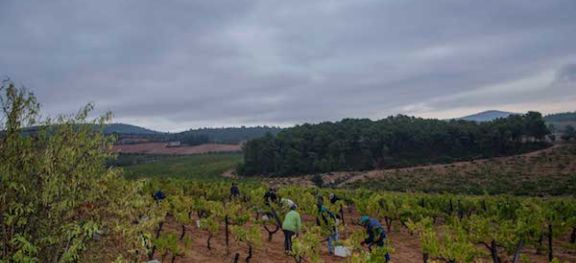Mustiguillo, Mestizaje Blanco 2016 Vino de España

From €8.59, £13.50, 172 Danish krone
Isn’t it amazing that this wine, made substantially from a grape variety of which more than 90% has been grubbed up over the past 25 years thanks to EU subsidies, is now available not just in its homeland Spain but also in the UK, Belgium, Germany, Austria and Denmark? And the 2015 (which I haven’t tasted but would love to try on the basis of how the 2016 showed at the end of June) is widely available in the US, the UK, Austria, Norway, Denmark and New Zealand, so presumably the 2016 will make its way there too.
We dismiss the grape in question, Merseguera, as ‘uninspiring’ in Wine Grapes but I think any new edition would have to take account of the commitment of Toni Sarrión of Mustiguillo, who seems to have found the perfect spot for it, at 900 m (2,950 ft) elevation in the mountains 80 km (50 miles) inland from Valencia on the Mediterranean coast.
He is known as Mr Bobal after his enthusiasm for the characteristic red wine grape of the region (one of the most planted in Spain) but at this elevation it just wouldn’t ripen. So he grafted the vines over to Merseguera, Valencia's own white wine grape and, after years of work, finally launched a single-vineyard example, Finca Calvestra 2012, enthusiastically reviewed here by our Spanish specialist Ferran Centelles three years ago.
It was at Berrys’ recent showing of their latest finds that Mustiguillo, Mestizaje Blanco 2016 Vino de España, a blend of 65% Merseguera, 24% Viognier and 11% Malvasia, caught my eye for value, but I see it is also stocked by at least another five independent wine retailers in the UK. Presumably it is the inclusion of Viognier that precludes any more precise appellation than Vino de España, but despite that French grape's strong personality, it does not dominate the blend. (Mestizaje, by the way, is Spanish for miscegenation.)
The 2016 vintage is the organically grown product of the driest summer since records began in the Valencia region but doesn’t taste stressed or as though there was a lack of juice in the grapes. This unoaked wine, which apparently is always made up of at least 50% of fruit from the Finca Calvestra vineyard shown here (note how well wrapped up are the pickers – this place is cool) is certainly big, broad and spicy but is enlivened by quite enough acidity. Aged on the lees, it was bottled in February. I found it seriously intriguing and unusual with real tension and interest. There is much complexity and depth here – particularly for a wine that Berrys are able to sell for £13.50 and costs less than €9 retail in Spain.
I might have been tempted to suspect that it was the Viognier and the Malvasia that added the interest to this 2016 blend but a tasting of the current vintage of the single-vineyard Mustiguillo, Finca Calvestra Merseguera 2014 Vino de España (£19.75 Berry Bros) proved otherwise. This 100% Merseguera, grown on limestone with a relatively high sandy loam component and aged in acacia barrels (20% new) for 12 months, was at least as good and even more ambitious than the Mestizaje blend. It reminded me rather of bitter lemon, so firm and almost bitter was the citrus element. It really did taste like a cool-climate wine – so unlike the Spanish stereotype and, like the Mestizaje, only 13.5% alcohol. Whereas the Mestizaje will probably be at its best over the next three years, I’d drink the Finca Calvestra 2014 between 2018 and 2021 – it’s serious stuff.
I commend both these wines to you and am eating humble pie over the word ‘uninspiring’. Purple Pages members should put Mustiguillo in the tasting notes search box to find our 14, generally very enthusiastic, tasting notes on these wines. The reds come from Mustiguillo's El Terrerazo vineyard that has its own Pago appellation.
Become a member to view this article and thousands more!
- 15,397 featured articles
- 274,704 wine reviews
- Maps from The World Atlas of Wine, 8th edition (RRP £50)
- The Oxford Companion to Wine, 5th edition (RRP £50)
- Members’ forum
- 15,397 featured articles
- 274,704 wine reviews
- Maps from The World Atlas of Wine, 8th edition (RRP £50)
- The Oxford Companion to Wine, 5th edition (RRP £50)
- Members’ forum
- Commercial use of our Tasting Notes
